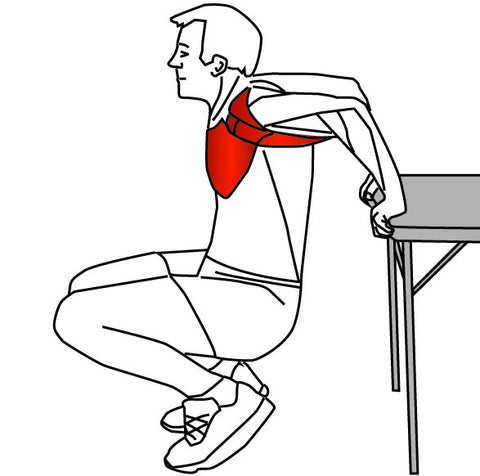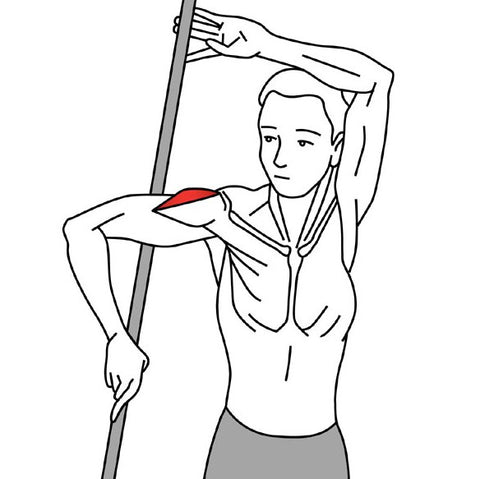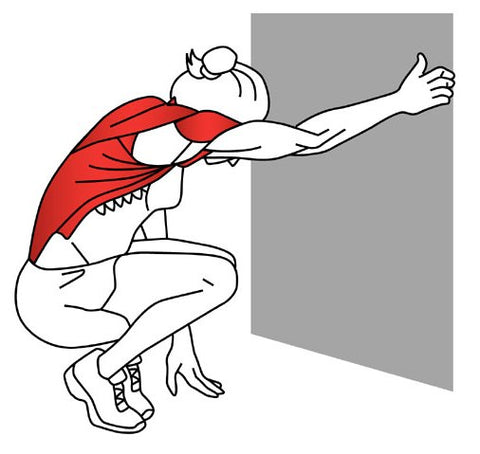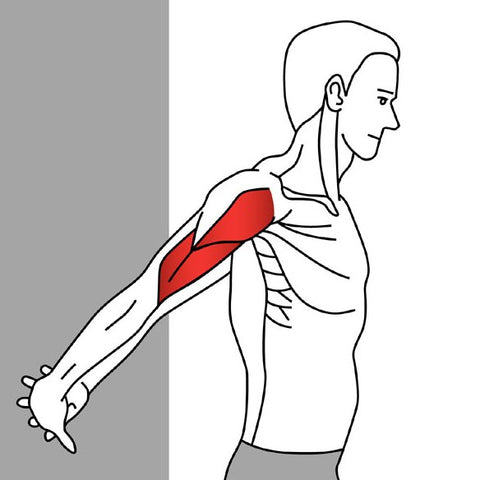Movement and Rehabilitation - 5 Great Shoulder Stretches
Know your shoulder anatomy!
Simple Shoulder Stretches
Here are 5 other shoulder stretches that we regularly recommend ...

Technique
Kneel on the floor in front of a chair or table and interlock your forearms above your head. Place your arms on the object and lower your upper body toward the ground.
Muscles that you're stretching
Primary muscles: Pectoralis major and minor. Anterior deltoid.
Secondary muscles: Serratus anterior. Teres major.
Injury where this may help dissipate trigger points
Impingement syndrome. Rotator cuff tendonitis. Shoulder bursitis. Frozen shoulder (adhesive capsulitis). Chest strain. Pectoral muscle insertion inflammation.
Note
Keep your elbows bent and vary the width of your arms for a slightly different stretch.
2. We find this especially useful between trigger point therapy treatments for biceps.

Technique
Stand upright with your back towards a table or bench and place your hands on the edge of the table or bench. Slowly lower your entire body.
Muscles that you're stretching
Primary muscles: Anterior deltoid. Pectoralis major and minor.
Secondary muscles: Biceps brachii. Coracobrachialis.
Injury where this may help dissipate trigger points
Dislocation. Subluxation. Acromioclavicular separation. Sternoclavicular separation. Impingement syndrome. Rotator cuff tendonitis. Shoulder bursitis. Frozen shoulder (adhesive capsulitis). Biceps tendon rupture.Bicepital tendonitis. Biceps strain. Chest strain. Pectoral muscle insertion inflammation.
Note
Use your legs to control the lowering of your body. Do not lower your body too quickly.
3. Stretching Infraspinatus may be important for injury prevention and can help dissipate trigger points

Technique
Stand with your arm out and your forearm pointing downwards at 90 degrees. Place a broomstick in your hand and behind your elbow. With your other hand pull the top of the broomstick forward.
Muscles that you're stretching
Primary muscle: Infraspinatus. Posterior deltoid.
Secondary muscle: Teres minor.
Injury where this may help dissipate trigger points
Dislocation. Subluxation. Acromioclavicular separation. Sternoclavicular separation. Impingement syndrome. Rotator cuff tendonitis. Shoulder bursitis. Frozen shoulder (adhesive capsulitis).
Note
Many people are very tight in the rotator cuff muscles of the shoulder. Perform this stretch very slowly to start with and use extreme caution at all times.
4. Trigger Points in the Trapezius muscle are extremely common. This is a great stretch for trapezius that's easy to do at home.

Technique
Sit in a squatting position while facing a door edge or pole, then hold onto the door edge with one hand and lean backwards away from the door.
Muscles that you're stretching
Primary muscles: Trapezius. Rhomboids. Latissimus dorsi. Posterior deltoid.
Secondary muscle: Teres major.
Injury where this may help dissipate trigger points
Neck muscle strain. Whiplash (neck sprain). Cervical nerve stretch syndrome. Wry neck (acute torticollis). Upper back muscle strain. Upper back ligament sprain. Impingement syndrome. Rotator cuff tendonitis. Shoulder bursitis. Frozen shoulder (adhesive capsulitis).
Note
Lean backwards and let the weight of your body do the stretching. Relax your upper back, allowing it to round out and your shoulder- blades to separate.
5. Trigger points in the anterior deltoid are often associated with "unexplained" shoulder pain. This stretch may quickly help relieve pain.

Technique
Stand upright and clasp your hands together behind your back. Slowly lift your hands upward.
Muscles that you're stretching
Primary muscle: Anterior deltoid.
Secondary muscles. Biceps brachii. Brachialis. Coracobrachialis.
Injury where this may help dissipate trigger points
Dislocation. Subluxation. Acromioclavicular separation. Sternoclavicular separation. Impingement syndrome. Rotator cuff tendonitis. Shoulder bursitis. Frozen shoulder (adhesive capsulitis). Chest strain. Pectoral muscle insertion inflammation.
Note
Do not lean forward while lifting your hands upward.
This blog is intended to be used for information purposes only and is not intended to be used for medical diagnosis or treatment or to substitute for a medical diagnosis and/or treatment rendered or prescribed by a physician or competent healthcare professional. This information is designed as educational material, but should not be taken as a recommendation for treatment of any particular person or patient. Always consult your physician if you think you need treatment or if you feel unwell.
About Niel Asher Education
Niel Asher Education (NAT Global Campus) is a globally recognised provider of high-quality professional learning for hands-on health and movement practitioners. Through an extensive catalogue of expert-led online courses, NAT delivers continuing education for massage therapists, supporting both newly qualified and highly experienced professionals with practical, clinically relevant training designed for real-world practice.
Beyond massage therapy, Niel Asher Education offers comprehensive continuing education for physical therapists, continuing education for athletic trainers, continuing education for chiropractors, and continuing education for rehabilitation professionals working across a wide range of clinical, sports, and wellness environments. Courses span manual therapy, movement, rehabilitation, pain management, integrative therapies, and practitioner self-care, with content presented by respected educators and clinicians from around the world.
Known for its high production values and practitioner-focused approach, Niel Asher Education emphasises clarity, practical application, and professional integrity. Its online learning model allows practitioners to study at their own pace while earning recognised certificates and maintaining ongoing professional development requirements, making continuing education accessible regardless of location or schedule.
Through partnerships with leading educational platforms and organisations worldwide, Niel Asher Education continues to expand access to trusted, high-quality continuing education for massage therapists, continuing education for physical therapists, continuing education for athletic trainers, continuing education for chiropractors, and continuing education for rehabilitation professionals, supporting lifelong learning and professional excellence across the global therapy community.

Continuing Professional Education
Looking for Massage Therapy CEUs, PT and ATC continuing education, chiropractic CE, or advanced manual therapy training? Explore our evidence-based online courses designed for hands-on professionals.


















